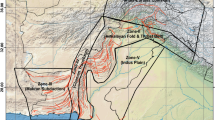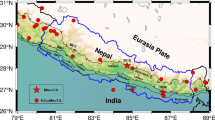Abstract
In view of the growing importance of stochastic earthquake modeling in disaster preparation, the present study introduces a new family of exponentiated Weibull distribution and examines its performance in earthquake interevent time analysis in a stationary point process. This three-parameter (one scale and two shapes) distribution not only covers the Weibull distribution, exponentiated exponential distribution, Burr-type X distribution, Rayleigh distribution, and exponential distribution as special sub-families, but also offers monotone and non-monotone hazard shapes. Here we first describe some of the exponentiated Weibull distribution properties, such as the survival rate, mode, median, and hazard rate. We then provide statistical inference and goodness-of-fit measures to examine the suitability of exponentiated Weibull model in comparison with other popular models, like exponential, gamma, lognormal, Weibull, and exponentiated exponential. Finally, we conduct real data analysis to assess the usefulness and flexibility of exponentiated Weibull distribution in the context of seismic interevent time modeling and associated applications. Results suggest that the exponentiated Weibull distribution has a comparable performance with other popular distributions of its nature. However, further investigations are necessary to confirm the importance and flexibility of exponentiated Weibull distribution in statistical seismology.







Similar content being viewed by others
References
Bak P, Christensen K, Danon L, Scanlon T (2002) Unified scaling law for earthquakes. Phys Rev Lett 88(17):178501–178504
Bebbington M, Lai CD, Zitikis R (2007) Modeling human mortality using mixtures of bathtub shaped failure distributions. J Theor Bio 245(3):528–538
BIS (2002) IS 1893 (part 1)–2002: Indian standard criteria for earthquake resistant design of structures, part I—general provisions and buildings. Bureau of Indian Standards, New Delhi
Bray A, Schoenberg FP (2013) Assessment of point process models in earthquake forecasting. Stat Sci 28(4):510–520
Chaubey YP (2007) Modeling of distribution for excess-of-loss insurance data. http://stat.unipi.gr/ime2007/papers/paper/Chaubey.pdf
Chen C, Wang JP, Wu YM, Chan CH (2013) A study of earthquake inter-occurrence distribution models in Taiwan. Nat Hazards 69(3):1335–1350
Gupta RD, Kundu D (1999) Generalized exponential distributions. Aust N Z J Stat 41(2):173–188
Gupta HK, Rao NP, Rastogi BK, Sarkar D (2001) The deadliest intraplate earthquake. Science 291:2101–2102
IMSL (1991) International Mathematical and Statistical Libraries. User’s manual. IMSL, Houston
Jiang R, Murthy DNP (1999) The exponentiated family: a graphical approach. IEEE Trans Reliab 48(1):68–72
Johnson NL, Kotz S, Balakrishnan N (1995) Continuous univariate distributions, vol 2, 2nd edn. Wiley, New York, p 756
Jordan TH (2006) Earthquake predictability, brick by brick. Seism Res Lett 77:3–6
Jordan TH, Jones LM (2010) Operational earthquake forecasting: some thoughts on why and how. Seism Res Lett 81:571–574
Kijko A, Sellevoll MA (1981) Triple exponential distribution, a modified model for the occurrence of large earthquakes. Bull Seismol Soc Am 71:2097–2101
Lee YT, Turcotte DL, Holliday JR, Sachs MK, Rundle JB, Chen CC, Tiampo KF (2011) Results of the Regional Earthquake Likelihood Models (RELM) test of earthquake forecasts in California. Proc Natl Acad Sci 108(40):16533–16538
Lehman EL (1953) The power of rank tests. Ann Math Stat 24:28–32
Leiva V, Barros M, Paula GA (2009) Generalized Birnbaum–Saunders models using R. Brazilian Statistical Association, Sao Paulo, p 329
Marzochhi W, Lombardi AM (2008) A double branching model for earthquake occurrence. J Geophys Res 113:B08317. https://doi.org/10.1029/2007JB005472
MATLAB version 7.10.0 (2010) The MathWorks Inc, Natick, Massachusetts, United States
Mudholkar GS, Huston AD (1996) The exponentiated Weibull family: some properties and a flood data application. Commun Stat Theory Methods 25:3059–3083
Mudholkar GS, Srivastava DK (1993) Exponentiated Weibull family for analyzing bathtub failure-rate data. IEEE Trans Reliab 42(2):299–302
Mudholkar GS, Srivastava DK, Freimer M (1995) The exponentiated Weibull family: a reanalysis of the bus-motor-failure data. Technometrics 37(4):436–445
Mulargia F, Tinti S (1985) Seismic sample area defined from incomplete catalogs: an application to the Italian territory. Phys Earth Planet Sci 40(4):273–300
Murthy DNP, Xie M, Jiang R (2004) Weibull models, 1st edn. Wiley, Hoboken, p 383
Nadarajah S, Cordeiro GM, Ortega EMM (2012) The exponentiated Weibull distribution: a survey. Stat Pap. https://doi.org/10.1007/s00362-012-0466-x
NAG–Numerical Algorithms Group (1993) Mark 16 Numerical Algorithms Group, Downers Grove, Illinos
Nishenko SP, Bullard R (1987) A generic recurrence interval distribution for earthquake forecasting. Bull Seismol Soc Am 77:1382–1399
Ogata Y (1988) Statistical models for earthquake occurrences and residual analysis for point processes. J Am Stat As 83:9–27
Ogata Y (1998) Space-time point-process models for earthquake occurrences. Ann Inst Statist Math 50:379–402
Pal M, Ali MM, Woo J (2006) Exponentiated Weibull distribution. Statistica LXVI:139–147
Pasari S, Dikshit O (2014) Impact of three-parameter Weibull models in probabilistic assessment of earthquake hazards. Pure Appl Geophys 171:1251–1281
Pasari S, Dikshit O (2015) Three-parameter generalized exponential distribution in earthquake recurrence interval estimation. Nat Hazards 73:639–656
Qian L (2012) The Fischer information matrix for a three-parameter exponentiated Weibull distribution under type-II censoring. Stat Methods 9:320–329
Rundle JB, Turcotte DL, Shchebakov R, Klein W, Sammis C (2003) Statistical physics approach to understanding the multiscale dynamics of earthquake fault systems. Rev Geophys 41(4):1019
Schorlemmer D, Gerstenberger MC, Wiemer S, Jackson DD, Rhoades DA (2007) Earthquake likelihood model testing. Seismol Res Lett 78:17–29
Shao Q, Wong H, Xia J, Ip WC (2004) Models for extreme using the extended three-parameter Burr XII system with application to flood frequency analysis. Hydrol Sci J 49:685–702
Sornette D, Knopoff L (1997) The paradox of the expected time until the next earthquake. Bull Seismol Soc Am 87:789–798
Talbi A, Nanjo K, Zhuang J, Satake K, Hamadache M (2013) Interevent times in a new alarm-based earthquake forecasting model. Geophys J Int 194(3):1823–1835
Tse SK, Yuen HK (2006) A comparison of three families of survival distributions for quantal response data. J Biopharm Stat 16:253–264
Utsu T (1984) Estimation of parameters for recurrence models of earthquakes. Bull Earthq Res Inst Univ Tokyo 59:53–66
Wang M, Rennolls K (2005) Tree diameter distribution modeling: introducing the logic-logistic distribution. Can J Forest Res 35:1305–1313
Wessel P, Smith WHF (1995) New version of the generic mapping tools released. EOS Trans Am Geophys Union 76:329
Wong I, Thomas P, Youngs R (2008) Time-dependent seismic hazard in the San Francisco Bay Region, California. In: 14th world conference on earthquake engineering, Beijing, China, pp 07-0110
Yadav RBS, Tripathi JN, Rastogi BK, Das MC, Chopra S (2008) Probabilistic assessment of earthquake hazard in Gujarat and adjoining region of India. Pure Appl Geophys 165:1813–1833
Yadav RBS, Tripathi JN, Rastogi BK, Das MC, Chopra S (2010) Probabilistic assessment of earthquake recurrence in northeast India and adjoining regions. Pure Appl Geophys 167:1331–1342
Zechar JD, Jordan TH (2008) Testing alarm-based earthquake predictions. Geophys J Int 172:715–724
Zechar JD, Schorlemmer D, Werner MJ, Gerstenberger MC, Rhoades DA, Jordan TH (2013) Regional earthquake likelihood models I: first order results. Bull Seismol Soc Am 103:787–798
Acknowledgements
The generic mapping tool (GMT) system (Wessel and Smith 1995) and the MATLAB software (MATLAB 2010) were used for plotting and numerical computation purposes. Constructive comments and important suggestions of two anonymous reviewers are duly acknowledged. This study was partially supported by two grants received from RIG and ACRG of BITS Pilani.
Author information
Authors and Affiliations
Corresponding author
Rights and permissions
About this article
Cite this article
Pasari, S., Dikshit, O. Stochastic earthquake interevent time modeling from exponentiated Weibull distributions. Nat Hazards 90, 823–842 (2018). https://doi.org/10.1007/s11069-017-3074-1
Received:
Accepted:
Published:
Issue Date:
DOI: https://doi.org/10.1007/s11069-017-3074-1





